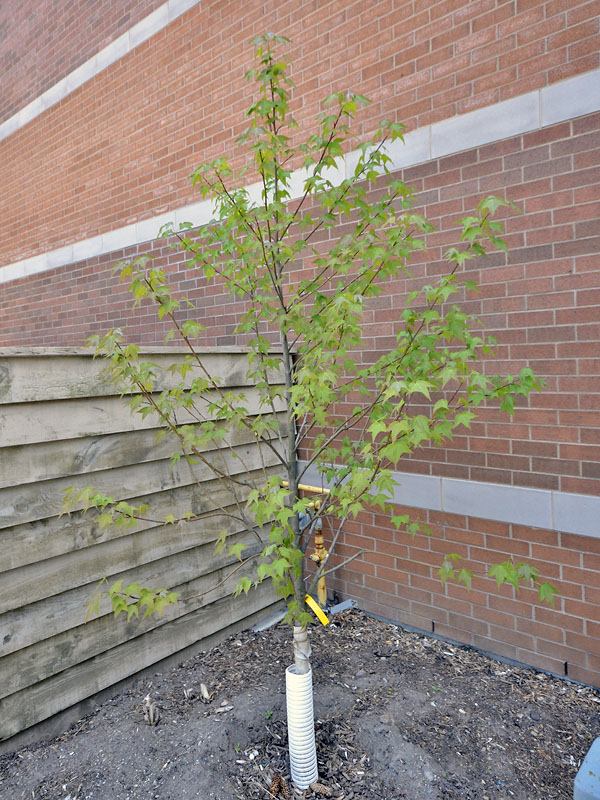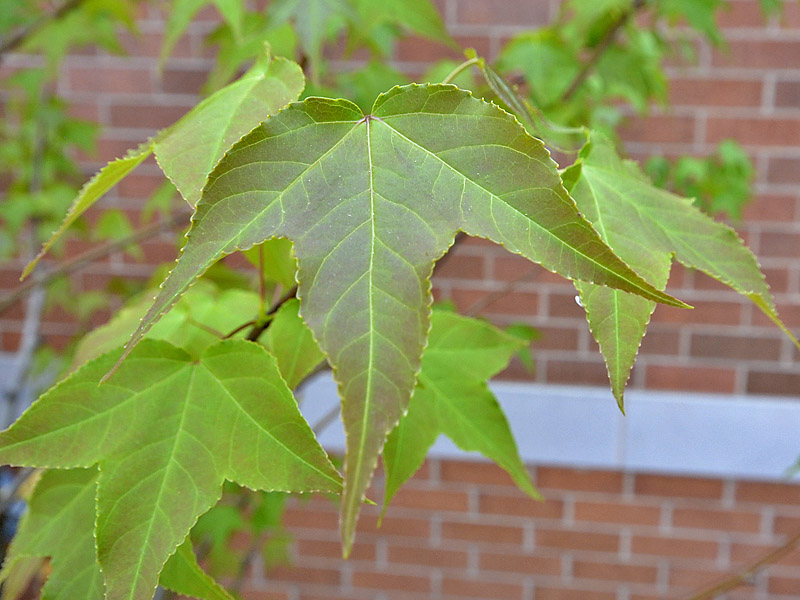
Woody > Liquidambar > Liquidambar styraciflua > Liquidambar styraciflua 'Burgundy'
Liquidambar styraciflua
'Burgundy'
Burgundy American Sweetgum
Origin: The Burgundy American Sweetgum was introduced by Maunsell Van Rensselaer in 1951 in conjunction with the Saratoga Horticultural Foundation, Saratoga, California and was introduced commercially by the Foundation in 1962.

"
The Burgundy American Sweetgum is known for its autumn rich, burgundy colour. It is a tree that requires room for growth as it has large, spreading root system and grows to be about 18-21 meters in height; thus it is a significant shade tree. The Burgundy American sweetgum is an adaptable hardwood that's able to thrive in both lowland and upland sites. It has a medium growth rate and is a strong wooded tree that develops an oval to rounded canopy when mature. As a young tree it has a columnar crown. During the summer the leaves are a deep glossy green but will turn a spectacular burgundy colour at the onset of autumn. The flower emerges in the spring and are then followed by spiny fruit that are called syncarps, also commonly known as gumballs. The flowers have no ornamental value because they are small and are hidden by the leaves. The fruit can be a litter problem because it is slow to decompose. The fruit may be considered ornamental because of their spiky, 'mace-like' form. All sweetgum trees produce a gum like substance called styrax that can be collected from the trunks by peeling the bark and scraping and collecting the resin below . This 'sweetgum' has been used medicinally, in perfumes and in chewing gum.
Michael Pascoe, NDP., ODH., CLT., MSc. (Plant Conservation)
"
| Family |
| Altingiaceae (Hamamelidaceae) |
| Genus |
| Liquidambar |
| Species |
| styraciflua |
| Cultivar |
| 'Burgundy' |
| Category |
| Woody |
| Type |
| Tree (deciduous) |
| USDA Hardiness Zone |
| 5-9 |
| Canadian Hardiness Zone |
| 5 |
| Temperature (°C) |
| -23 - (-29) |
| Temperature (°F) |
| -9 - (-20) |
| Height |
| 18- 21 m |
| Spread |
| 10- 15 m |
| General Description |
| Burgundy American Sweetgum is a deciduous, large sized tree with glossy green leaves during the summer that turn to glamourous burgundy autumn colour. The leaves have 5-7 points with finely toothed margins that look like stars. The bark is grayish-brown with stems that are aromatic, rounded or somewhat angled and can be prominent with corky ridges. |
| Landscape |
| The Burgundy American Sweetgum is known for its rich, glossy, red-purple autumn colour, making it a distinct ornamental tree. It its 5-7 lobed, deeply cut leaves longer than the other cultivars persist until mid-winter. The trees is an ideal lawn or shade tree for large residences and parks since it has dense foliage but also an extensive root systems. The Burgundy American sweetgum is drought tolerant and is thus a very hardy tree. The fruit may be considered ornamental because of their spiky, 'mace-like' form. |
| Cultivation |
| Plant in full sun, ideally in the spring, in deep, moist, and slightly acid soils. They are difficult to transplant, because the root system is fleshy and lacks extensive fibrous roots resulting in a longer re-establishment process after transplanting when compared to most other tree species. |
| Shape |
| Symmetrical canopy with a dense oval-pyramidal crown. |
| Growth |
| Medium |
| ID Characteristic |
| During the autumn its leaves turn a purple to reddish colour (burgundy). The tree produces fruit that are distinctly shiny and resemble a medieval mace ball but are commonly referred to as gum balls. The tree has gummy substance (resin) that bleeds when a branch or limb is severed during its active growing period.. |
| Pests |
| It has no major pests or diseases. Some minor problems may be fall webworm, tent caterpillar, sweetgum scale, leaf miners which causes brown blotches to appear on the leaves and leaf spot. |
| Habitat |
| Horticultural origin. |
| Bark/Stem Description |
| Burgundy American sweetgum has shiny, brown to grayish bark with deep furrows and narrowed ridges. The tree has thick bark which resists injury however if the tree is injured it will develop a resin blister at the wounding site through a series of small channels where specialised cells are found. This resin helps minimize insect invasion and assists in tree wound compartmentalization and healing . |
| Flower/Leaf Bud Description |
| The terminal buds are ovate or conical, can have up to 6-8 scales and can be 0.5-1 cm long. The lateral buds are smaller and have a reddish-green-brown colour. When the buds are crushed they release a resinous odor. |
| Leaf Description |
| The Burgundy sweetgum leaves are mainly known for their purple to reddish autumn colour which has great ornamental value. Leaves are star-shaped with 5-7 lobes that are straight, acute and serrated with axillary tufts on the main veins abaxial. The leaf type is simple and has a distinctive palmate venation with 5 prominent veins from the notched base. The leaf blade can grow to be 10-20 cm wide. During the summer Burgundy Sweetgum has glossy dark green foliage that either alternates along the terminal stems or clusters on the lateral shoots. During the winter, in mild conditions the leaves will persist on the trees. |
| Flower Description |
| Flowers are greenish yellow and are ornamentally insignificant because they are hidden in the emerging foliage. The flowers are monoecious, the female flowers are found on slender stocks that are about 1 cm in diameter and the male flowers are found in upright terminals. |
| Fruit Description |
| The shiny, ball-like fruit that resemble a mace fruit are called syncarps which are dehiscent capsules that are winged and are about 2.5-3.5 cm in diameter. During the summer they are green but turn brown during the autumn. The fruit can remain on the tree from November to April. |
| Colour Description |
| During the summer the leaves are a rich, glossy green but during autumn turn to a purple-reddish colour. The bark is brown to grayish and the new growth is green-brown. The flowers are greenish- yellow formed in clusters. The fruit during spring is yellowish-green but turn brown in autumn. When a twig is broken red sap (resin) appears. |
| Texture Description |
| Medium leaf and medium in winter. |
| Notable Specimens |
| The Gardens at Fanshawe College, London, Ontario, Canada. The Glinna Arboretum ,Szczecin Voivodeship, Glinna, Poland. |
| Propagation |
| Micro-propagated or graft onto the rootstock of the species. The ideal time to graft is the winter. To graft cut a scion about 7-8 cm long with at least 2 buds, then shape the end of the scion into a wedge and remove some of the bark. To prepare the stock you need to cut a slant on a smooth area near the base of the under stock. The cut should extend at a downward angle and should reach the base (potted 1-2 year old seedlings are ideal). Open the cut and insert the scion, you may need to secure it with grafting film and/or elastic. Once the scion starts to grow cut the remaining under stock back as close to the graft as possible. |

